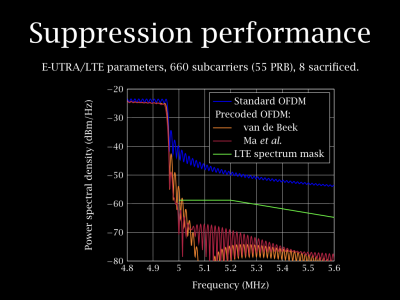Documents
Poster
Orthogonal Precoding for Sidelobe Suppression in DFT-Based Systems Using Block Reflectors

- Citation Author(s):
- Submitted by:
- Ian Clarkson
- Last updated:
- 12 March 2017 - 8:31pm
- Document Type:
- Poster
- Document Year:
- 2017
- Event:
- Presenters:
- Vaughan Clarkson
- Paper Code:
- SPCOM-P4.10
- Categories:
- Log in to post comments
Sidelobe suppression has always been an important part of crafting communications signals to keep interference with users of adjacent spectrum to a minimum. Systems based on the discrete Fourier transform, such as orthogonal frequency-division multiplexing (OFDM) and single-carrier frequency-division multiple access (SC-FDMA) are especially prone to out-of-band power leakage. Although many techniques have been proposed to suppress sidelobes in DFT-based systems, a satisfactory balance between computational complexity and out-of-band power leakage has remained elusive.
Orthogonal precoding is a promising, linear technique in which the nullspace of a precoding matrix with orthonormal columns is designed to suppress the sidelobes. In particular, Xu and Chen, van de Beek and Ma et al. have proposed orthogonal pre-coders that yield excellent out-of-band suppression. However, they suffer from high arithmetic complexity—quadratic in the number of active subcarriers—which has limited their application.
In this paper, we find that the arithmetic complexity can be made linear instead of quadratic if a block reflector is used to perform the precoding instead of an otherwise unstructured unitary transformation. There is no penalty to be paid in achieved bit-error rate. We show by numerical simulation that the penalty in peak-to-average power ratio is also very small for OFDM.

